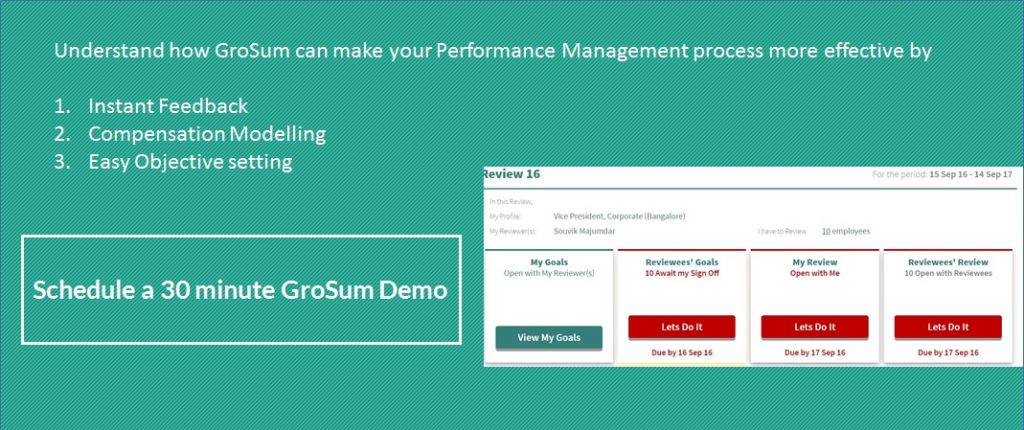
Have you ever felt that changes in performance management have not yielded the desired results?
Past strategies to improve performance management have failed, mainly because of the lack of focus on value and more on administrative setups. Changes to improve the performance management process over the past has been with respect to:
- Rating Scale
- Parameters to rate: objective, result, behaviors, contributors, individual
- Who rates whom
- Change the type of Goals and competencies: SMART Goals, HARD goals, KRAs.
These changes have failed to make performance management a daily part of the work culture. In-fact these impart poor performance management behavior, where the performance review process is only active at a certain time.
Above changes still make performance management a burdensome activity for administrative purposes.
So why even after changes the performance management still remains a criticized process? There might not be a comprehensive answer to this, but the reason largely remains to perceptions like organizations use performance management to remove the worst performers, justify salary increments.
Do we at all need a formal performance management process? Yes, a formal process helps to get some information on employee performance and communicate objectives.
Read ahead to know the necessary changes required in the performance management process to make it a part of your daily activity. By the end of reading this document, you will know how to tweak the traditional performance management to create a high performing culture.
We will discuss a new approach to traditional performance management, to help you drive ongoing performance management behavior. These 8 points will be highly actionable points which you can work upon.
#1 Organization Alignment:
A new approach to organization alignment is to clearly define and articulate mission and discussion of the employee fit towards it. It becomes important to focus on the ‘bigger picture’. Important is to make employees understand the expectation, and how they can achieve their objectives.
As part of the new approach, make sure that organizational alignment is due to employee-role alignment, employee-goal alignment, employee-team alignment, employee-organization alignment.
An older approach to this is cascading goals. As part of the information, goals are just passed on. Though goals are broken down, employees fail to see the bigger picture, the employer is looking to achieve.
#2 Goals:
State ongoing expectations as work evolves. Setting expectations and then assessing it after 8-12 weeks makes more sense. Based on current progress, needs, and revise expectations to move towards the final result.
The older approach was to define goals like New Year resolution and trying to strictly follow it. Though the approach was noble (to achieve the final target) that steps taken to achieve could be revised. Gone are the days when you define SMART goals at the beginning of every year.
#3 Development:
Development is part of the daily routine, just like having breakfast or taking a bath. Ongoing development is part of the leadership function, where an employee and managers connect on an ongoing basis. Discussion, mentoring, coaching takes place on what can be learned to become more efficient.
The primitive way to change development in Performance Management is to decide on a generic formal training defined in the middle of the year. The reluctance to discuss development issues between employees and managers on a daily basis is due to trust factors and low level of engagement.
#4 Feedback:
Make feedback part of the regular discussions at work. Feedback which is regular, be it on the floor, or immediate (based on performance triggers) helps to create better interaction. Immediate feedback fuels development energizes teams and makes performance better.
An older approach to ‘change’ in the feedback process is to make feedback mandatory but at once or twice a year, making it a disinterested and apprehensive process. It doesn’t make sense to place feedback at the end for the work done at the start of the year.
#5 Performance Ratings:
Simplified rating scales, which have a small number of factors defined by standards. This helps to use them in a better and simpler manner. A simple rating scale helps to capture critical objectives and reduce the burden of performance reviews.
The primitive way to change ratings for Performance Management was to introduce an elaborate numerical rating scale, which looked to convey decisions. They increase the administrative burden and friction between people and process.
#6 Training:
Training programs for employees and managers on a day to day behavior. Behavior at the workplace to achieve the designated goals and tasks.
Earlier approaches to changing the training methodology included training only for managers. A training program using this approach is usually generic and not based on employee day to day behavior.
#7 Process Flow and Procedures:
Streamlined, easy and frictionless – that is how the process flow and procedures need to be. To create a high culture performance organization which embraces performance management, employees will love a process which is streamlined and has simple procedures.
In an older process, performance management would be an extensive process, with difficult documentation.
#8 Evaluation & Monitoring:
Monitoring is done to understand if the present process is fulfilling its value or not. Quick Surveys, feedback to understand whether the above process is creating value and not only just completed. This helps to know whether managers are mentoring or not, understand what people think about the goal they have been asked to achieve.
The older approach was all about completing steps and not concentrating on the value. Like an administrative burden, which needs to be completed for the sake of it and documentation purposes.
Take Away
Despite various researches, Performance Management still stands as a venerable spot in human capital management. There have been changes in the past to make the process more viable and fulfill its purposes, the ‘old-approaches’ haven’t worked out quite well.
Reinventing Performance Management means a reduction in administrative process, imparting trust between employee and managers and making it a regular activity, the above implementation may take time and drastic changes on your culture, but if done properly can yield high results and take employee engagement and performance through the roof.
